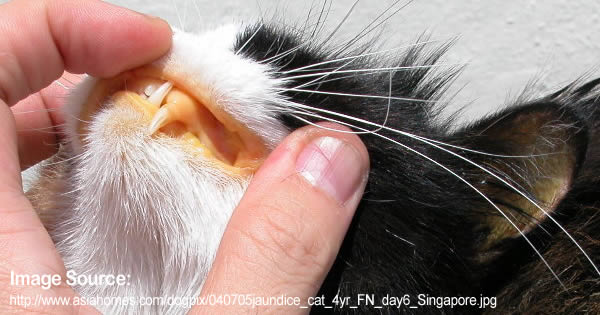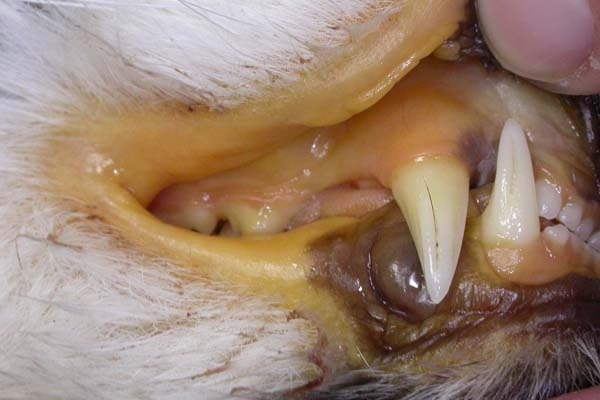Cats’ gums can turn yellow due to several potential causes such as jaundice, liver disease or anemia. If your cat’s gums have turned yellow, it is important to consult a veterinarian to determine the underlying cause and provide appropriate treatment.
Yellow gums in cats can indicate a serious health issue. Jaundice, a condition characterized by an excess of bilirubin in the bloodstream, can cause the gums to turn yellow. This condition may be caused by liver disease, anemia, or other medical conditions.
Liver disease, such as hepatitis or cirrhosis, can disrupt the liver’s ability to process bilirubin properly, leading to its buildup in the bloodstream. Anemia, a decrease in red blood cell count, can also cause yellowing of the gums. In any case, it is crucial to seek veterinary attention promptly to ensure the well-being of your feline companion.

Credit: www.petpremium.com
Understanding Cat Gum Health
Understanding cat gum health is crucial for cat owners to ensure the overall well-being of their furry friends. One important aspect of cat gum health is the color of the gums, as it can indicate potential health issues. Normal gum color in cats is typically pale pink or light pink.
However, if you notice that your cat’s gums have turned yellow, it may be a cause for concern. Yellow gums in cats can be indicative of various underlying conditions. Some common causes of yellow gums in cats include jaundice, liver disease, dehydration, gum infections, and anemia. If you observe yellow gums in your cat, it is essential to seek veterinary advice for an accurate diagnosis and appropriate treatment.
Maintaining good cat gum health is essential for their overall health and wellbeing. Regular check-ups, proper dental care, and a healthy diet can contribute to healthy gums and prevent potential complications.
Symptoms And Signs Of Yellow Gums In Cats
Yellow gums in cats can be a cause for concern as it may indicate an underlying health issue. Observing changes in gum color is one way to detect the problem. Normally, a cat’s gums should have a pink coloration. If you notice a yellowish hue, it could suggest anemia, jaundice, liver disease, or an infection.
Other accompanying symptoms that might accompany yellow gums include lethargy, loss of appetite, vomiting, diarrhea, and weight loss. It’s important to keep a close eye on your cat’s behavior and overall well-being.
If you observe yellow gums in your cat, seeking veterinary care is crucial. A professional veterinarian will be able to diagnose the underlying cause and recommend appropriate treatment.
Potential Health Issues Associated With Yellow Gums In Cats
Yellow gums in cats can be indicative of potential health issues that should be addressed. Dental and gum diseases are one possible cause of this discoloration. Poor oral hygiene and tartar buildup can lead to gum inflammation and infection, resulting in yellowing gums. Regular dental care, including professional cleanings, can help prevent these issues.
Anemia and blood disorders can also manifest as yellow gums in cats. These conditions can lead to a decrease in red blood cells and oxygen supply, causing pale or yellowish mucous membranes, including the gums. Identifying and treating the underlying cause of the anemia is crucial to resolving this symptom.
Liver dysfunction and jaundice can also lead to yellow gums in cats. When the liver is not functioning properly, bilirubin (a yellow pigment) builds up in the body, resulting in jaundice. Yellowing of the gums can be a visible sign of this condition and should be evaluated by a veterinarian to determine the cause and appropriate treatment.
Preventive Measures For Maintaining Healthy Gums In Cats
Regular dental hygiene is essential for maintaining healthy gums in cats. Brushing your cat’s teeth regularly using a specially designed feline toothbrush and toothpaste is recommended. This helps remove plaque and tartar buildup, preventing gum disease.
Proper nutrition and diet play a crucial role in gum health. Feeding your cat a balanced diet that includes high-quality cat food is important. Avoid feeding them excessive amounts of soft food, as it can contribute to dental problems. Providing stimulating chew toys can also promote good gum health by encouraging cats to chew and clean their teeth naturally.
Seeking Veterinary Diagnosis And Treatment
If you notice that your cat’s gums are yellow, it is crucial to seek veterinary examination and diagnostic tests to determine the underlying cause. A veterinarian will conduct a thorough physical examination of your cat, including an evaluation of their gums, teeth, and overall oral health. Diagnostic tests may be recommended to further assess the situation, such as blood work, a complete blood count (CBC), and a dental exam. These tests can help identify potential health issues that may be causing the yellowing of the gums, such as liver or kidney disease, dental inflammation or infection, or anemia.
The appropriate treatment for yellow gums will depend on the specific diagnosis. If a dental issue is the cause, a professional cleaning or extraction of affected teeth may be necessary. In cases where an underlying health condition is identified, such as liver or kidney disease, treatment will aim to manage and address these conditions. This may involve medication, dietary changes, or other interventions as determined by the veterinarian. It is essential to follow the veterinarian’s advice and administer any prescribed treatments to help restore your cat’s gum health.
To address the underlying health conditions contributing to yellow gums, it is important to follow the veterinarian’s recommendations closely. This may include providing necessary medications, making dietary modifications, and scheduling regular follow-up appointments for continuous monitoring and adjustments to the treatment plan, if needed. By addressing the root cause, you can help improve your cat’s overall health and prevent further complications.
Conclusion
Yellow gums in cats can be a sign of various underlying health issues that require prompt veterinary attention. From dental problems to liver disease, it’s essential to identify the cause and address it accordingly. By regularly monitoring your cat’s oral health and seeking professional advice, you can ensure their overall well-being.
Remember, keeping your cat’s gums healthy plays a crucial role in their overall health and happiness.


